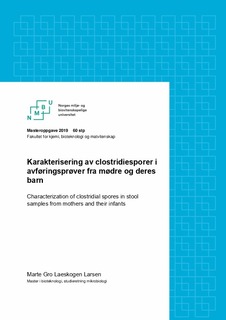| dc.contributor.advisor | Rudi, Knut | |
| dc.contributor.advisor | Avershina, Ekaterina | |
| dc.contributor.author | Larsen, Marte Gro Laeskogen | |
| dc.coverage.spatial | Norway | nb_NO |
| dc.date.accessioned | 2019-08-13T08:50:40Z | |
| dc.date.available | 2019-08-13T08:50:40Z | |
| dc.date.issued | 2019 | |
| dc.identifier.uri | http://hdl.handle.net/11250/2608053 | |
| dc.description.abstract | Etableringen av tarmmikrobiotaen er en dynamisk og ikke-tilfeldig prosess. Proteobacteria og Actinobacteria dominerer hos nyfødte, før Bacteroides og Firmicutes øker dominansen en tid etter fødselen. Voksnes tarmmikrobiota domineres av bakterier innen klassen Clostridia, som omfatter obligat anaerobe, sporedannende bakterier. Det er antatt at disse bakteriene koloniserer tarmen via sporer, men det er fortsatt uklart når og hvordan dette skjer. I denne masteroppgaven ble det utviklet en protokoll for å isolere DNA fra clostridiesporer i avføringsprøver. De vegetative cellene ble drept ved å behandle prøvene med likt volum av 70% etanol i fire timer, før vegetativt DNA ble fjernet med ethidium monoazide (EMA) som binder seg kovalent til DNA under lyseksponering. Antall 16S rRNA-kopier ble kvantifisert med qPCR og avføringsprøvene ble sekvensert med Illumina-sekvensering. Klassen Clostridia hadde en signifikant økning i relativ mengde av 16S rRNA-kopier etter etanol- og EMA-behandling ved 3-10 dager og 4 måneders alder, men ikke for barn 1 år, 2 år og mødrene. Tre OTUer tilhørende klassen Clostridia og én OTU tilhørende klassen Bacilli ble funnet med signifikant høyere relativ mengde 16S rRNA-kopier etter etanol- og EMA-behandling i forhold til ved kun etanolbehandling både hos barna og hos mødrene og ble karakterisert som sporer. De tre Clostridia-OTUene tilhørte Peptostreptococcaceae, Romboutsia og Clostridium senso stricto. Bacilli-OTUen ble karakterisert som Turicibacter og det ble antatt at denne var sporedannende. OTUene har senere blitt bekreftet som etanolresistente ved dyrkning. Det ble ikke funnet indikasjoner på at disse OTUene var overført fra mor til barn ved fødsel og det ble antatt at de hadde opprinnelse fra omgivelsene. De tre Clostridia-OTUene viste økt antall DNA-kopier ved ett års alder i forhold til tidligere prøvetidspunkter, både i kun etanolbehandlete og i etanol- og EMA-behandlete prøver. Det er mulig bakteriene kommer inn i tarmen som sporer og ligger latent til betingelsene er gunstige rundt ett års alder. Det ble funnet indikasjoner på at EMA til en viss grad trengte inn i sporene, men nedgangen i antall DNA-kopier var høyere for vegetativt DNA og det var derfor mulig å skille DNA fra sporer og vegetative celler fra hverandre. Det er allikevel nødvendig å optimalisere metoden ytterligere for å kunne karakterisere flere sporer. | nb_NO |
| dc.description.abstract | The establishment of the gut microbiota is a dynamic and non-random process. Phylum Proteobacteria and Actinobacteria dominates the gut of infants, before Bacteroides and Firmicutes becomes the dominating phylums. The adult gut microbiota is dominated by Clostridia, which include obligate anaerobe, spore forming bacteria. It is assumed that these bacteria colonize the gut as spores, but it is still unclear when and how this happens. In this master thesis a protocol has been developed to isolate DNA from clostridial spores in stool samples. The vegetative cells were killed by treatment with 70% ethanol for four hours before DNA was removed by ethidium monoazide (EMA), that covalently binds to DNA when exposed to light. The number of 16S rRNA copies was quantified by qPCR and the stool samples was sequenced by Illumina sequencing. The Clostridia class had a significant enrichment after EMA treatment for children 3-10 days and 4 months of age, but not for children at 1 and 2 year of age and the mothers. Three Clostridia OTUs and one Bacilli OTU had a significant higher relative amount of 16S rRNA gene copies after ethanol- and EMA treatment compared to only ethanol treated samples in both the children and the mothers. These OTUs were characterized as spores. The three Clostridia OTUs belonged to Peptostreptococcaceae, Romboutsia and Clostridium senso stricto. The Bacilli OTU was characterized as Turicibacter and it was assumed to be spore forming bacteria. The four OTUs have later been confirmed as ethanol resistant bacteria in a culturing experiment. There were no indications that these OTUs were transferred from mother to child at birth and were believed to originate from the environment. The three Clostridia OTUs showed an increased number of DNA copies at 1 year of age in both ethanol treated and ethanol- and EMA-treated samples, and the bacteria may have an early colonization as spores but stay dormant until around 1 year of age. There were indications that EMA penetrated the spores to some extent, but the decrease in DNA copies was higher for vegetative DNA and it was therefore possible to distinguish between the spores and vegetative DNA. It is nevertheless necessary to further optimize the method in order to characterize more spores. | nb_NO |
| dc.language.iso | nob | nb_NO |
| dc.publisher | Norwegian University of Life Sciences, Ås | nb_NO |
| dc.rights | Attribution-NonCommercial-NoDerivatives 4.0 Internasjonal | * |
| dc.rights.uri | http://creativecommons.org/licenses/by-nc-nd/4.0/deed.no | * |
| dc.subject | Clostridia | nb_NO |
| dc.subject | Sporer | nb_NO |
| dc.subject | Tarmmikrobiota | nb_NO |
| dc.title | Karakterisering av clostridiesporer i avføringsprøver fra mødre og deres barn | nb_NO |
| dc.title.alternative | Characterization of clostridial spores in stool samples from mothers and their infants | nb_NO |
| dc.type | Master thesis | nb_NO |
| dc.subject.nsi | VDP::Mathematics and natural science: 400::Basic biosciences: 470::General microbiology: 472 | nb_NO |
| dc.subject.nsi | VDP::Technology: 500::Biotechnology: 590 | nb_NO |
| dc.source.pagenumber | 59 | nb_NO |
| dc.description.localcode | M-BIOTEK | nb_NO |

